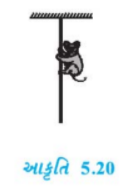A monkey of mass 40 kg climbs on a rope Fig. 5.20 which can stand a maximum tension of 600 N. In which of the following cases will the rope break: the monkeya climbs up with an acceleration of 6 m s–2b climbs down with an acceleration of 4 m s–2c climbs up with a uniform speed of 5 m s–1d falls down the rope nearly freely under gravity?Ignore the mass of the rope.
Case aMass of the monkey m = 40 kgAcceleration due to gravity g = 10 m/sMaximum tension that the rope can bear Tmax = 600 NAcceleration of the monkey a = 6 m/s2 upwardUsing Newton’s second law of motion we can write the equation of motion as:T – mg = maT = mg + a= 40 10 + 6= 640 NSince T > Tmax the rope will break in this case.Case bAcceleration of the monkey a = 4 m/s2 downwardUsing Newton’s second law of motion we can write the equation of motion as:mg – T = maT = m g – a= 4010 – 4= 240 NSince T < Tmax the rope will not break in this case.Case cThe monkey is climbing with a uniform speed of 5 m/s. Therefore its acceleration is zero i.e. a = 0.Using Newton’s second law of motion we can write the equation of motion as:T – mg = maT – mg = 0T = mg= 40 × 10= 400 NSince T < Tmax the rope will not break in this case.Case dWhen the monkey falls freely under gravity its will acceleration becomes equal to the acceleration due to gravity i.e. a = gUsing Newton’s second law of motion we can write the equation of motion as:mg – T = mgT = mg – g = 0Since T < Tmax the rope will not break in this case.
Related Solutions
A monkey of mass 40 kg climbs on a rope (Fig. 5.20) which can stand a maximum tension of 600 N. In which of the following cases will the rope break: the monkey (a) climbs up with an acceleration of 6 m s^2 (b) climbs down with an acceleration of 4 m s^2 (c) climbs up with a uniform speed of 5 m s^1 (d) falls down the rope nearly freely under gravity? (Ignore the mass of the rope).

View SolutionA monkey of mass 40 kg climbs on a rope (fig) which can stand a maximum tension of 600 N. In which of the following case will the rope break the monkey
(a) climbs up with an acceleration of 6 m
(b) climbs down with an acceleration of 4 m
(c ) climbs up with a uniform speed of 5 m
(d) falls down the rope nearly freely under gravity
(Ignore the mass of the rope)

View SolutionA monkey of mass 40 kg climbs on a rope. which can stand a maximum tension of 600 N. In which of the following cases will the rope break: the monkey (a) climbs up with an acceleration of (b) climbs down with an acceleration of (c) climbs up with a uniform speed of (d) falls down the rope nearly freely under gravity? (Ignore the mass of the rope).

View SolutionA monkey of mass 40 kg climbs on a rope. which can stand a maximum tension of 600 N. In which of the following cases will the rope break: the monkey (a) climbs up with an acceleration of 6 m s^(-2) (b) climbs down with an acceleration of 4 m s^(-2 ) (c) climbs up with a uniform speed of 5 m s^(-1) (d) falls down the rope nearly freely under gravity? (Ignore the mass of the rope).
View SolutionA monkey of mass 40 kg climbs on a rope. which can stand a maximum tension of 600 N. In which of the following cases will the rope break: the monkey (a) climbs up with an acceleration of (b) climbs down with an acceleration of (c) climbs up with a uniform speed of (d) falls down the rope nearly freely under gravity? (Ignore the mass of the rope).

View SolutionA monkey of mass 40kg climbs on a rope (Fig. 5.20) which can stand a maximum tension of 600 N. in which of the following cases will the rope break: the monkey:- climbs down with an acceleration of

View SolutionA monkey of mass 40kg climbs on a rope (Fig. 5.20) which can stand a maximum tension of 600 N. in which of the following cases will the rope break: the monkey:- climbs up with a uniform speed of

View SolutionA monkey of mass 40 kg climbs a rope. Which can stand a maximum tension of 600 N. In which of the following cases will the rope break: The monkey
climbs up with a uniform speed of 5 m
View SolutionA monkey of mass 40 kg climbs on a rope (Fig) . Which can stand a maximum tension of 600 N .In which of the following cases will the rope break : the money (a) climbs up with an acceleration of 6 m s^(-2) (b) climbs dow with an acceleration of 4ms^(-2) (c ) climbs up with a uniform speed of 5 ms^(-1) falls down the rope nearly freely under gravity ? ( ignore the mass of the rope )
View SolutionA monkey of mass 40 kg climbs on a rope which can withstand a maximum tension of 600 N.In which of the following cases with the rope break? The monkey-
climbs down with an acceleration of 4 m
View SolutionA monkey of mass 40 kg climbs on a rope which can withstand a maximum tension of 600 N.In which of the following cases will the rope break? The monkey- climbs up with an acceleration of 6 m cdot s^(-2)
View SolutionA monkey of mass 40 kg climbs on a rope as shown in figure which can stand a maximum tension of 600 N. In which of the following cases will the rope break the monkey.

(a) Climbs up with an acceleration of 6 .
(b)Climbs down with an acceleration of 4 .
(c )Climbs up with a uniform speed of 5 .
(d)Falls down the rope nearly freely under gravity ? (Ignore the mass of the rope).
View SolutionA monkey of mass 40 kg climbs on a rope which can withstand a maximum tension of 600 N In which of the following cases will the rope break : The monkey
(a) climbs up with an acceleration of
(b) climbs down with an acceleration of
(c) climbs up with a uniform speed of
(d) falls down the rope nearly freely under gravity ? (Ignore the mass of the rope.)
View Solution40 kg નો એક વાંદરો એક દોરડું ( આકૃતિ 5.20 ) કે જે મહત્તમ 600 Nનું તણાવ ખમી શકે છે તેના પર ચઢે છે . નીચેનામાંથી કયા કિસ્સામાં દોરડું તૂટી જશે ? : વાંદરો ની નિયમિત ઝડપથી ઉપર ચડે છે .

View SolutionA monkey of mass 40 kg climbs on a rope which can withstand a maximum tesion of 600 N In which of the following cases will the rope break ? The monkey (a) climbs up with an acceleration of 6 ms^(-2) (b) climbs down with an acceleration of 4 ms^(-2) (c) climbs up with a unifrom speed of 5 ms^(-1) (d) falls down the rope nearly freely under gravity Ignore the mass of the rope .
View SolutionA monkey of mass 40 kg climbs on a rope which can withstand a maximum tesion of 600 N In which of the following cases will the rope break ? The monkey (a) climbs up with an acceleration of 6 ms^(-2) (b) climbs down with an acceleration of 4 ms^(-2) (c) climbs up with a unifrom speed of 5 ms^(-1) (d) falls down the rope nearly freely under gravity Ignore the mass of the rope .
View SolutionThe mass of a monkey is 40 kg. It is climbing a rope which can bear a tension of maximum 600 N. In which of the following cases will the rope break? Monkey (i) 6 m/s upwards "से"^(2) climbs with an acceleration of . (ii) 4 m/s downwards "से"^(2) comes from acceleration. (iii) climbs upwards with a uniform velocity of 5 m/s. (iv) falls freely on the rope under gravity. (g = 10 m/s) "से"^(2) Let the mass of the rope be negligible.
View SolutionA monkey of mass 40 kg climbs a rope. Which can withstand a maximum tension of 600 N. In which of the following cases will the rope break: The monkey
falls down the rope nearly under gravity
[ ignor the mass of the rope. Take g = 10 m]
View SolutionA monkey of mass 40 kg climbs on a rope which can withstand a maximum tension of 600 N.In which of the following cases with the rope break? The monkey- climbs up with a uniform speed of 5 m cdot s^(-1) (lgnore the mass of the rope. Take g = 10 m cdot s^(-2)
View SolutionA monkey of mass 40kg climbs on a rope (Fig. 5.20) which can stand a maximum tension of 600 N. in which of the following cases will the rope break: the monkey:-
View Solution